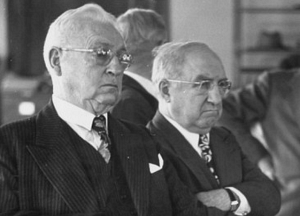Posted: May 28, 2015
Source: In These Times
 When Daniel J. Tobin was inducted in the Labor Hall of Fame last week, few modern Americans had any idea who he was.
When Daniel J. Tobin was inducted in the Labor Hall of Fame last week, few modern Americans had any idea who he was.
This is understandable, as Tobin, who died in 1955, retired uneventfully from the Teamsters union more than 60 years ago. And even in his heyday as a labor leader in the New Deal and World War II eras, he was overshadowed by more flamboyant union figures like John L. Lewis of the United Mine Workers, or Harry Bridges of the West Coast longshore workers. But Tobin well deserves recognition in the Hall of Fame, according to some modern observers, for laying the foundations for one of the country’s largest and most powerful unions.
What stands out initially about Tobin’s career was his extraordinary longevity as Teamsters president, says Karin Jones, director of the Teamster History Project. First elected as union president in 1907, he would serve in that role until 1952, a full 45 years. Although nominally the union’s second president (the first, Cornelius Shea, was driven from office by charges of criminal misconduct), Tobin emerged as the dominant figure of early Teamsters history, presiding over its astonishing growth—from 40,000 to 1.1 million members—and its development into a truly national organization, Jones says.
With 45 years in office, there is a lot of material to work with, Jones says, so the Teamster History Project has created a special section on the Teamsters web site to educate modern union members on his history at the union’s helm. It traces the evolution of the union from a handful of widely scattered locals of barely organized transport workers into a modern labor organization—with Tobin providing a steadying hand through some turbulent times.
— Read the complete source story.
[divider_top]
